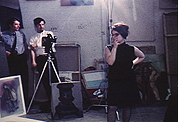Commissioned and published by Fandor in September 2010. — J.R.
Teaching silent film in the mid-1980s at the University of California, Santa Barbara, I was astonished to discover I was the first teacher there who had ever shown a film by Louis Feuillade. Sadly, there was a good reason: at that time, only one Feuillade film was in distribution in the U.S. — Juve contre Fantômas (Juve vs. Fantômas) — and few if any of my teaching colleagues had ever seen it.
My own introduction to Feuillade, one of the most memorable filmgoing experiences in my life, was attending, on April 3, 1969, a 35-millimeter projection of all seven hours of his 1918 crime serial, Tih Minh, at the Museum of Modern Art -– along with Susan Sontag, Annette Michelson, and other enrapt friends and acquaintances. Part of the shock of that experience was discovering that even though Feuillade was a contemporary of D.W. Griffith — born two years earlier, in 1873 — he seemed to belong to a different century. While Griffith reeks of Victorian morality and nostalgia for the mid-19th century, Feuillade looks forward to the global paranoia, conspiratorial intrigues, and technological fantasies of the 20th century and beyond.




